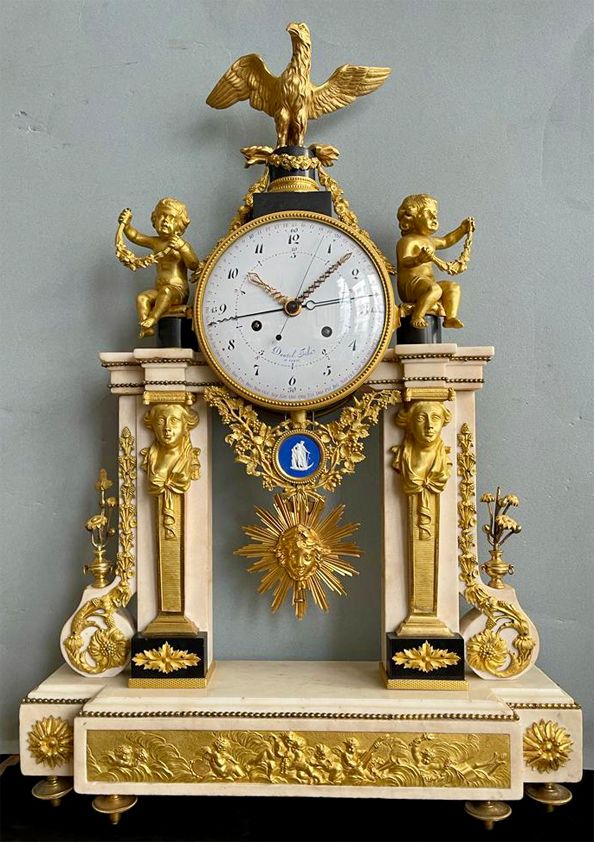Description
Portico clock in white and black marble, decorated with chased and gilded bronze, portico decorated with sheaths with bust of draped woman surmounted on both sides of the movement of putti holding a garland of flowers, a phoenix rising from its ashes at the top of the whole. It is flanked by fruit motifs ending in twists and flower pots. Base with a frieze of loves on clouds. Apron with vine decoration, in the center of it a medallion in Sèvres biscuit decorated with Chronos "en pause" White enamel dial with duodecimal and decimal, 30-day calendar on the upper half of the periphery, 3 decades in lower symmetry. The central indication is graduated for the revolutionary hours in black from 1 to 5, in red from 6 to 10, above the decimal hours in black. The 30 days of the date follow in red Arabic numerals, blue for 10, 20 and 30 on the circumference of the dial, the days of the decade, 3 decadi in blue are on the lower circumference. Indication of the seconds with central second hand. Graham 30 teeth escapement at the back of the plates. In the centre, the blade suspension is located at the back of the plates, as well as the balance wheel. Signed in blue on the dial "DAUTEL Fils à Paris". This Louis XVI period clock was delivered after October 24, 1794 (3 Brumaire An II) H. 65,5 cm - W. 75 cm - D. 12 cm Claude-Aimé DAUTEL , Watchmaker installed in Paris from 1790 to 1820, Rue de Bucy, then Place Dauphine (Source Tardy)
150
Portico clock in white and black marble, decorated with chased and gilded bronze, portico decorated with sheaths with bust of draped woman surmounted on both sides of the movement of putti holding a garland of flowers, a phoenix rising from its ashes at the top of the whole. It is flanked by fruit motifs ending in twists and flower pots. Base with a frieze of loves on clouds. Apron with vine decoration, in the center of it a medallion in Sèvres biscuit decorated with Chronos "en pause" White enamel dial with duodecimal and decimal, 30-day calendar on the upper half of the periphery, 3 decades in lower symmetry. The central indication is graduated for the revolutionary hours in black from 1 to 5, in red from 6 to 10, above the decimal hours in black. The 30 days of the date follow in red Arabic numerals, blue for 10, 20 and 30 on the circumference of the dial, the days of the decade, 3 decadi in blue are on the lower circumference. Indication of the seconds with central second hand. Graham 30 teeth escapement at the back of the plates. In the centre, the blade suspension is located at the back of the plates, as well as the balance wheel. Signed in blue on the dial "DAUTEL Fils à Paris". This Louis XVI period clock was delivered after October 24, 1794 (3 Brumaire An II) H. 65,5 cm - W. 75 cm - D. 12 cm Claude-Aimé DAUTEL , Watchmaker installed in Paris from 1790 to 1820, Rue de Bucy, then Place Dauphine (Source Tardy)
